Last updated on July 21, 2023
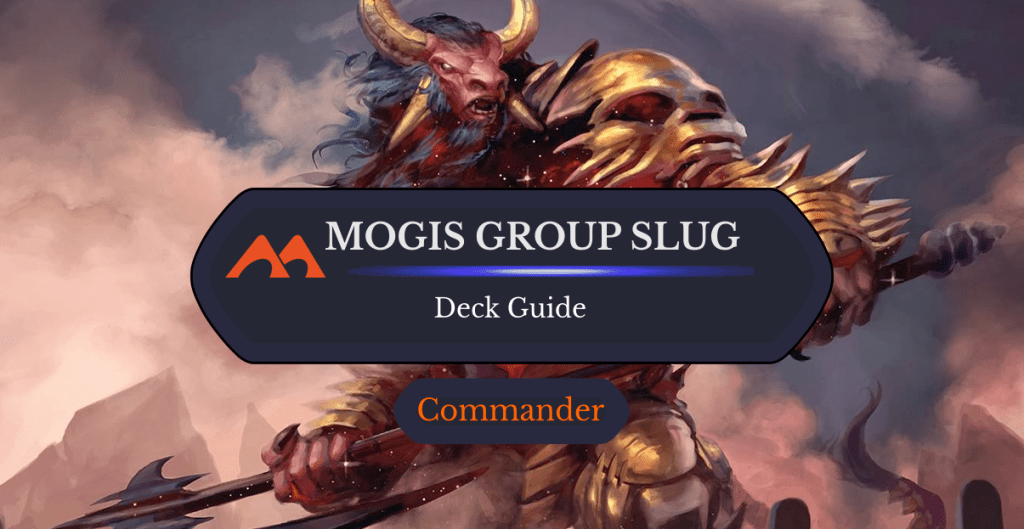
Mogis, God of Slaughter | Illustration by Peter Mohrbacher
Every Commander player knows the joy of playing with a group hug player. That one person who serenades the table and gives out gifts with Zedruu the Greathearted or Kynaios and Tiro of Meletis, spreading joy with extra cards and mana from things like Collective Voyage and Howling Mine.
This deck is group hug’s meaner cousin, looking to punish rather than give. Group slug decks are all about making your opponents rethink every action they take because every game action has consequences. Mogis, God of Slaughter makes a perfect commander to lead this deck, so let’s jump in!
The Deck
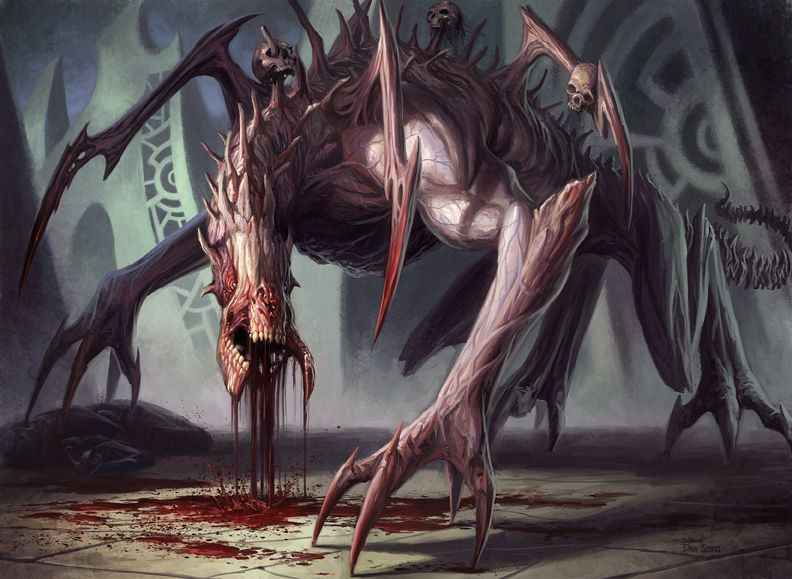
Kederekt Parasite | Illustration by Dan Scott
Commander (1)
Planeswalkers (4)
Daretti, Scrap Savant
Chandra, Torch of Defiance
Chandra, Awakened Inferno
Daretti, Ingenious Iconoclast
Creatures (6)
Rug of Smothering
Kederekt Parasite
Rampaging Ferocidon
Magus of the Moon
Solphim, Mayhem Dominus
Erebos, God of the Dead
Instants (7)
Rakdos Charm
Soul Shatter
Tibalt's Trickery
Valakut Awakening
Malakir Rebirth
Pyroblast
Vampiric Tutor
Sorceries (18)
Wildfire
Boom // Bust
Night's Whisper
Disrupt Decorum
Obliterate
Decree of Annihilation
Blasphemous Act
Tectonic Break
Brotherhood's End
Dreadbore
Gamble
Vandalblast
Jokulhaups
Shatterskull Smashing
Ruination
Agadeem's Awakening
Damnation
Toxic Deluge
Enchantments (15)
Sulfuric Vortex
Underworld Dreams
Impending Disaster
Manabarbs
Death Pits of Rath
Smoke
City on Fire
Spellshock
Lethal Vapors
Tainted Aether
Furnace of Rath
Price of Glory
Blood Moon
Fiery Emancipation
Polluted Bonds
Artifacts (16)
Mind Stone
Fellwar Stone
Arcane Signet
Rakdos Signet
Planar Atlas
Sol Ring
Realmbreaker, the Invasion Tree
Gilded Lotus
Thought Vessel
Crawlspace
Talisman of Indulgence
Caltrops
Thran Dynamo
Ankh of Mishra
Ensnaring Bridge
Crucible of Worlds
Lands (33)
Drownyard Temple
Drossforge Bridge
Command Tower
Bojuka Bog
Darksteel Citadel
Dragonskull Summit
Fabled Passage
Takenuma, Abandoned Mire
Luxury Suite
Haunted Ridge
Blood Crypt
Prismatic Vista
Mountain x11
Swamp x9
Bloodstained Mire
Much as group hug decks look to reward and make friends with everybody, group slug wants to inflict as much pain on the pod as possible. This list and general strategy can make you the enemy of the table.
This is a burn deck, but it’s slow-acting rather than blisteringly fast. A traditional burn strategy doesn’t mesh well with the nature of Commander, so you’ve got a bunch of steady burn sources to take your opponents down over time and some defensive pieces to protect yourself while you wait.
Many of these defenses are artifacts and enchantments that prevent your opponents from attacking you or at least punish them for doing so. You’ve also got a couple of board wipes kicking around to keep the table under control.
The best defense in this deck is also the most contentious: land destruction! I’m not talking about a Strip Mine or Wasteland floating around to deal with the occasional Gaea's Cradle or Ancient Tomb. It's honest-to-goodness mass land destruction, seeking to destroy your opponents' mana base to buy the time you need to end the game.
The Commander
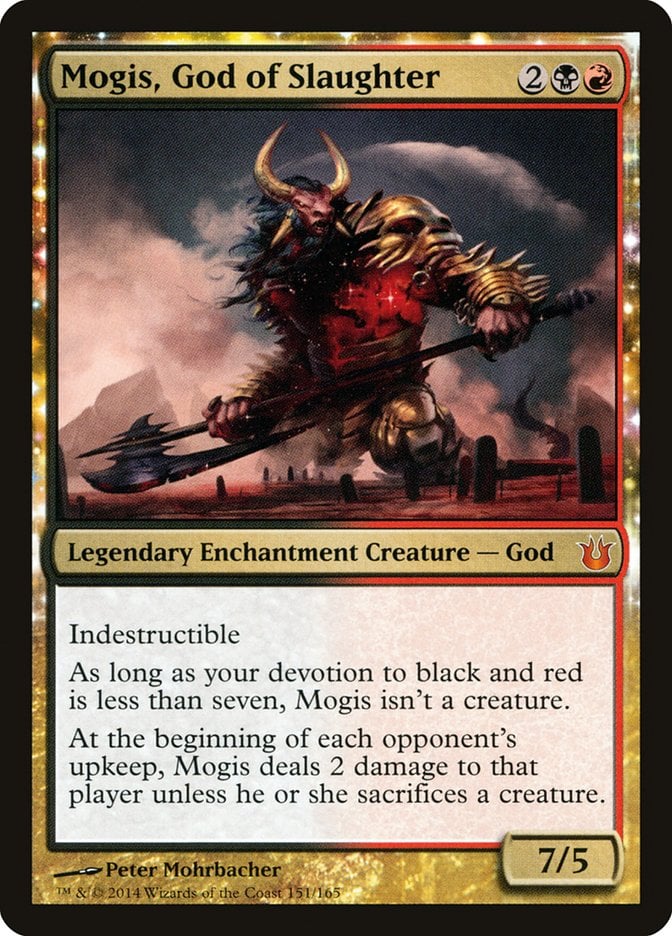
Mogis, God of Slaughter lends itself quite well to this kind of strategy. It’s an enchantment most of the time in this deck, sitting back to keep the pressure on your opponents. Taking two every upkeep doesn’t seem bad, but it stacks up quickly, especially once you throw in a couple of cards that double or triple your damage.
Indestructibility is key here. You have board resets that destroy creatures and artifacts in addition to lands, which is why enchantments are so important to this deck. If Mogis is already a creature, it’ll be a massive beater that takes out your opponents while they struggle to rebuild their boards.
Mogis's constant pressure along with its ability to attack and block while ignoring most forms of interaction make it an ideal commander for this deck. It’s also resistant to many of your defensive pieces that destroy creatures.
Land Destruction
This is why we’re all here. How do you attack opponents’ mana most effectively? By destroying it!
Magus of the Moon and Blood Moon aren’t explicitly land destruction, but they hit the same notes. You’ve got tons of basics, so these don’t hurt you. This effect can be hit or miss; you’ll be pretty sad to draw this in a pod with mono-colored players, but these come down early and are effective enough to be worth the risk.
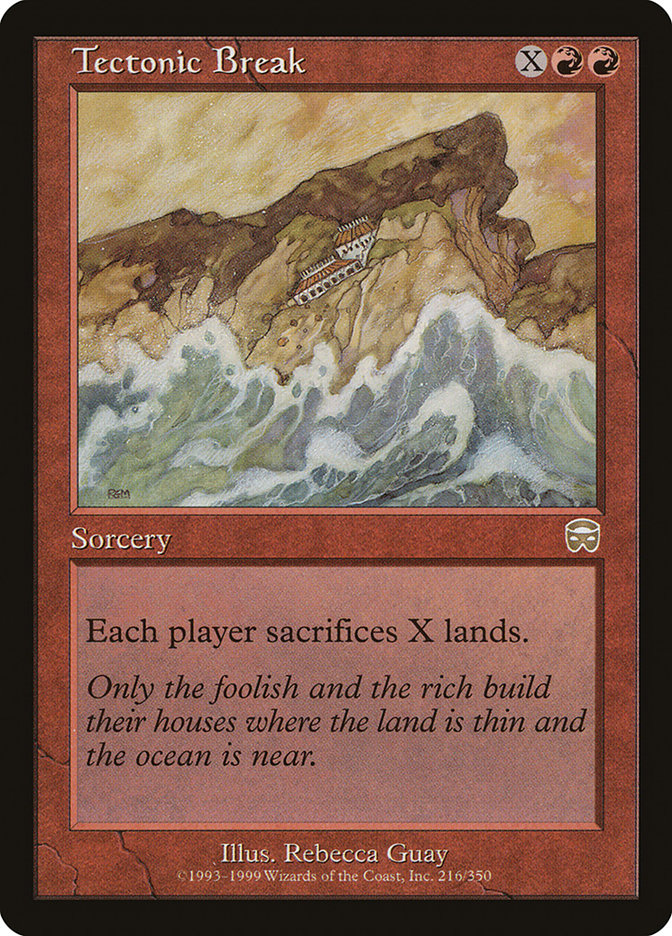
Tectonic Break is a land destruction spell you want to cast after ramping with artifacts because paying the cost with your lands means you’ll never get all the lands in play unless another player is behind. It circumvents the occasional indestructible land and gives you a lot of flexibility. It's the only option that lets you decide how many lands are axed, so you can cast this for a small number if you want to keep some lands or X=10 to wipe the board.
Jokulhaups and Obliterate often reset the board by destroying everything. These are the cards that make Mogis’s indestructible so vital. Your artifacts can get caught in the destruction, but more often than not, this resets the board for all players. I’m happy to reset the game with a Mogis or Underworld Dreams in play.
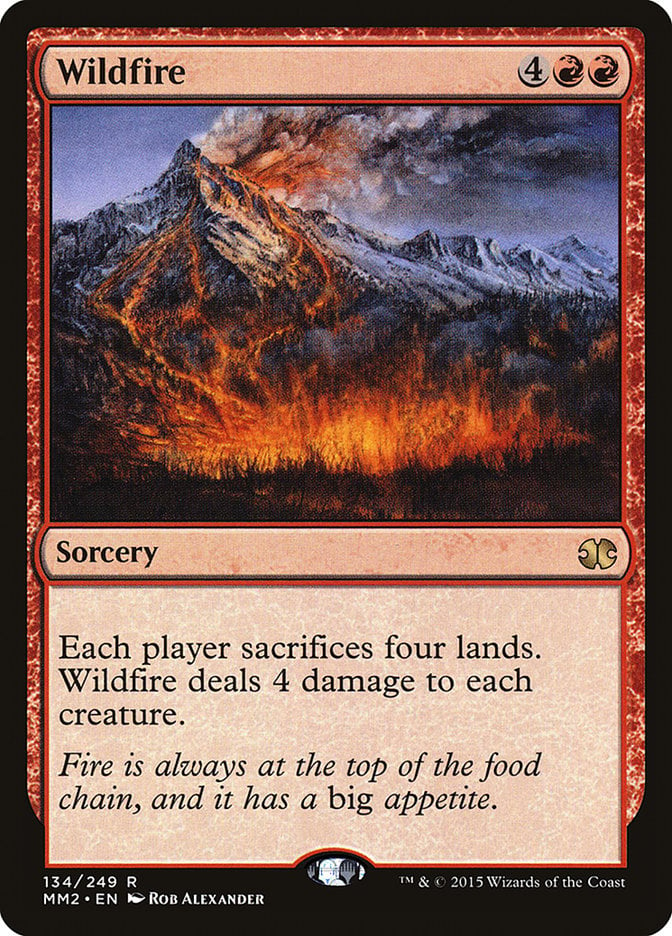
Wildfire is a great land destruction spell to power out early since it puts everybody behind in lands and creatures. This deck needs to deal with creatures because you don’t run many, and most players want to take you out because of land destruction. Don't sacrifice your indestructible lands if you can help it.
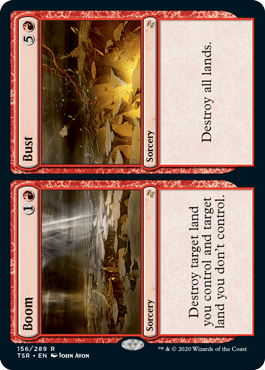
Boom // Bust is a split card, but you’re mostly playing it to use Bust. Boom is inefficient in a multiplayer pod since you’re putting yourself and one other player behind, generating a virtual mana advantage for the other two. The only time to use Boom is if somebody is about to pop off with a Cabal Coffers or Gaea's Cradle and it’s your only option to stop them.
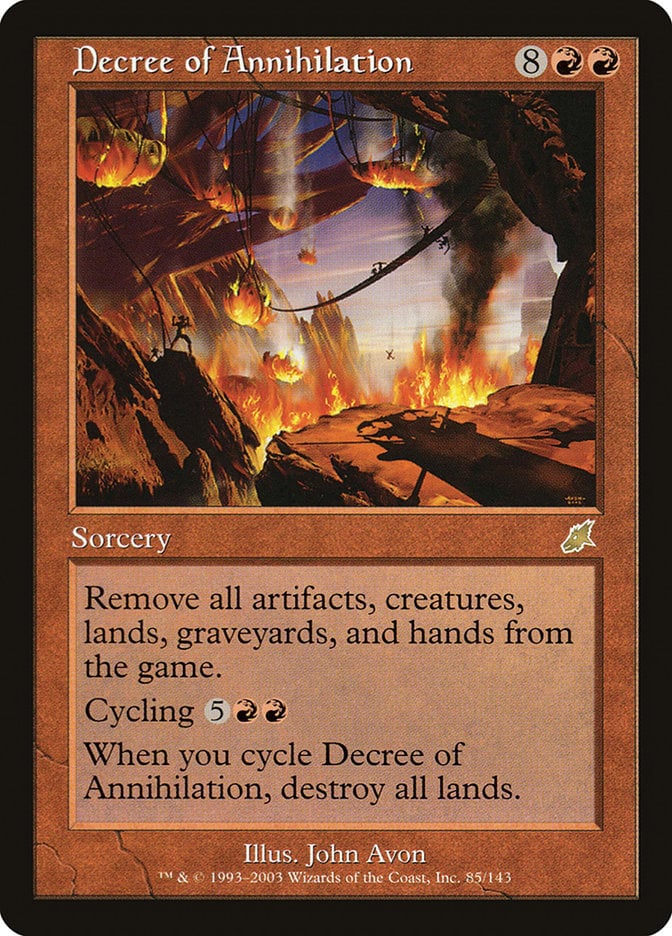
Decree of Annihilation is a much harder game reset than anything else we’ve looked at. You can cycle it for expensive land destruction or cast it to try and win. Decree doesn’t hit enchantments or planeswalkers, so you can leave yourself with a robust board state. If possible, try to cast this when your devotion is too low for Mogis to be a creature so that it escapes annihilation.
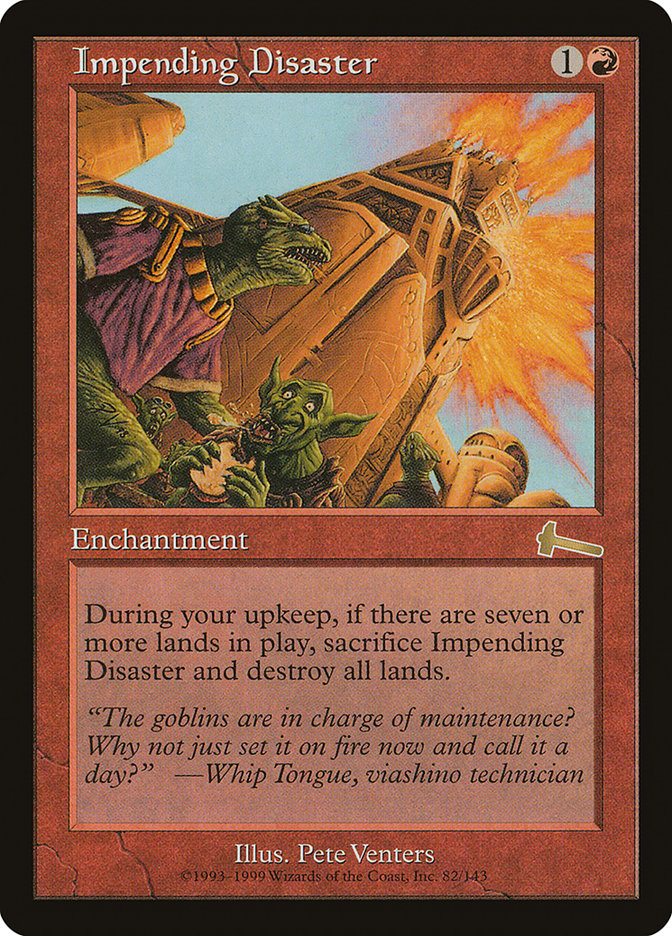
Impending Disaster is your cheapest land destruction effect, though it takes a little time to go off. It’s a great card to drop on turn two before enough lands are in play to destroy it. It creates an interesting mood around the table, and some people will play chicken with one another to try and avoid hitting the 7-land threshold. If your opponents aren’t playing lands, you’ve basically destroyed them already!
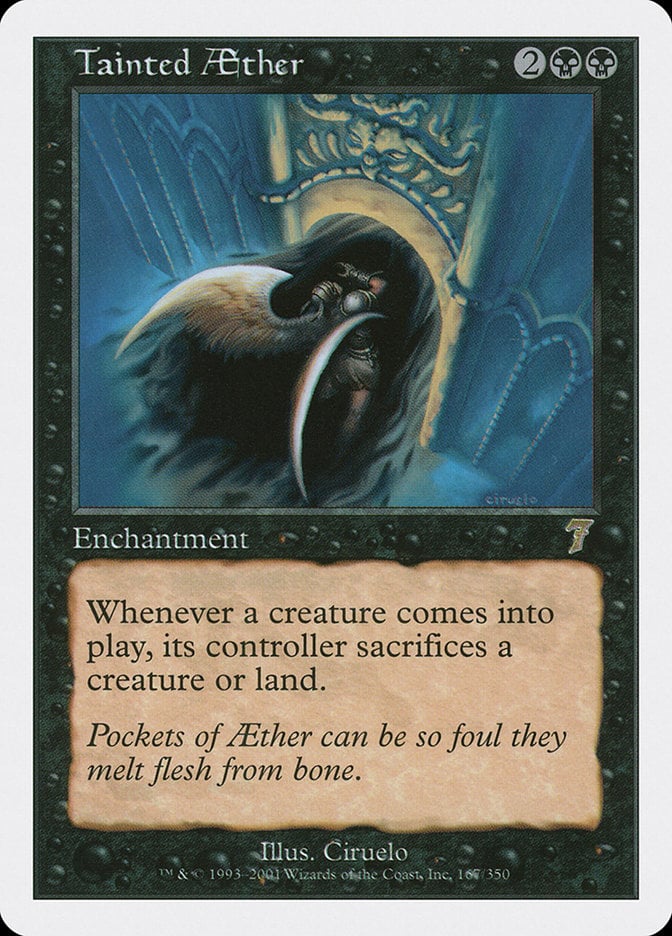
Tainted Aether is an enchantment to make a tokens player cry. It's land destruction and a defensive piece, especially when played early. It puts a real tax on anybody playing with a bunch of small creatures instead of big ones and is lethal against players who ramp with mana dorks.

Ruination is your best land destruction spell. Like Blood Moon, it’s not effective in every matchup, but it’s so easy for this to be completely one-sided and blow out your opponents when you’ve only played basics. When it works, this is the best tool to set your opponents behind while staying ahead yourself. This also has some of my favorite flavor text in all of Magic.
Protective Pieces
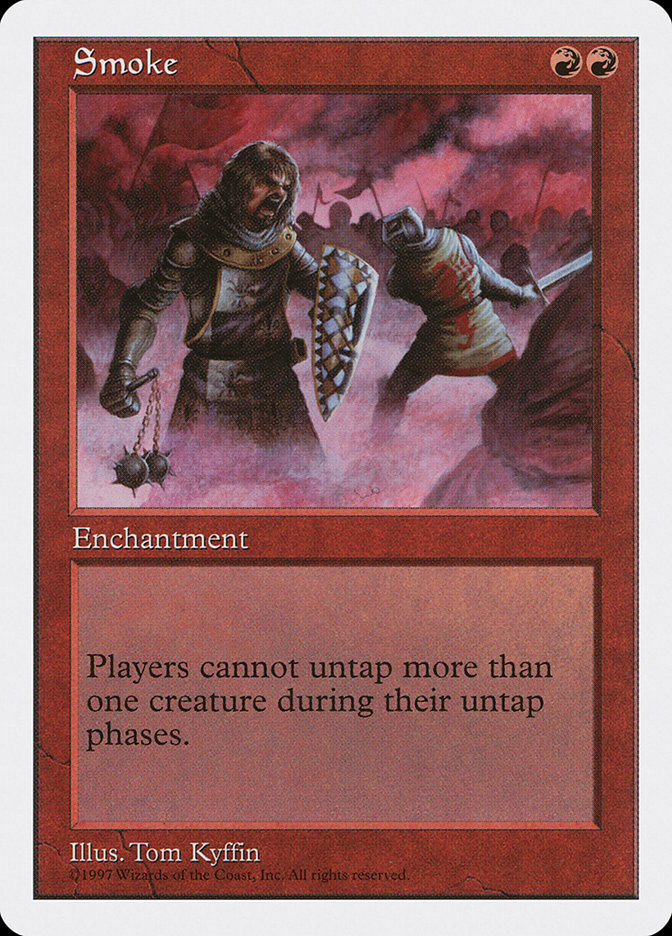
Smoke is a fantastic card that’s basically Winter Orb but for creatures. It stops anybody trying to go wide from throwing a billion creatures at your face. It gets bonus points for making mana dorks awkward.

Ensnaring Bridge is a classic. You’ll run your hand out pretty quickly with your mana rocks. You have some expensive cards that can fill your hand up, but holding one or two cards won’t be too bad. Ensnaring Bridge is mostly here to stop the massive creatures from getting you.
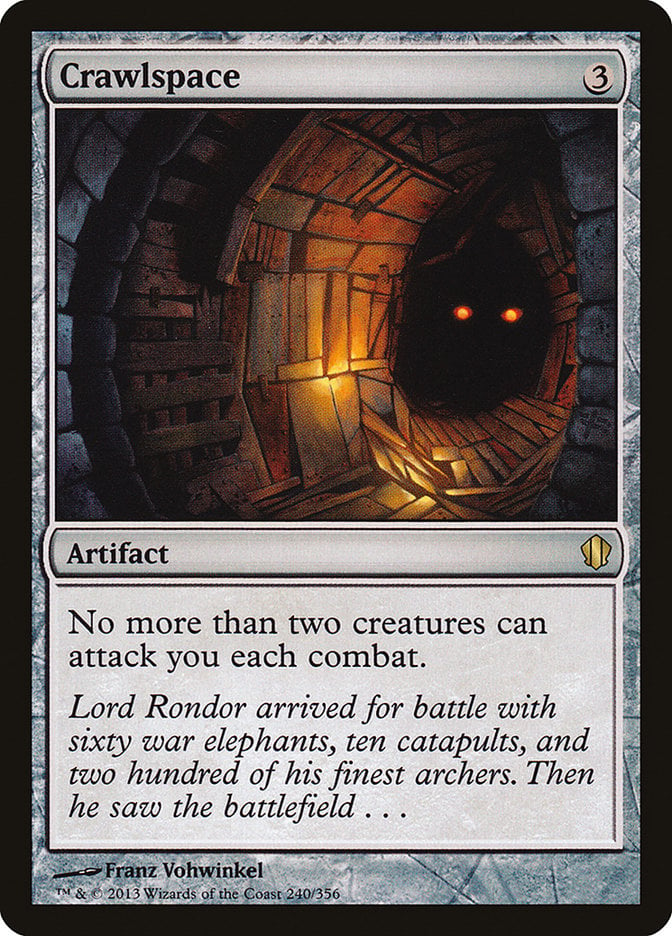
Crawlspace is another card that limits your opponents from attacking you with too many creatures. Completely stopping attackers and damage is hard in Rakdos, but this is another tool that slows the damage you take to a trickle to buy as much time as possible.
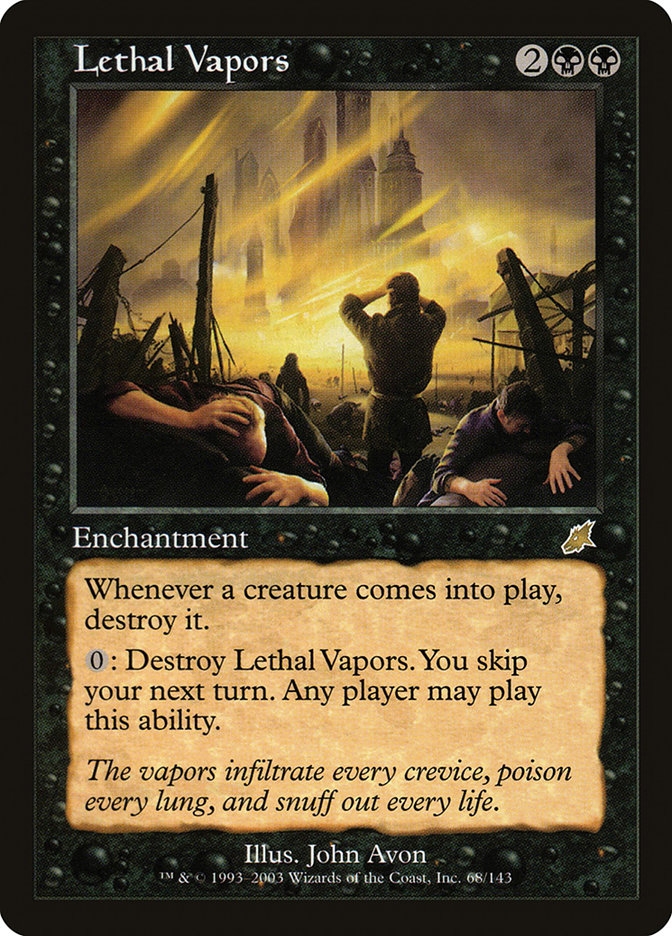
Lethal Vapors asks opponents if they can win without playing creatures. You may get a hero willing to sacrifice a turn for the table, but just a few turns of this card sitting around buys a lot of time. If you can’t power this out, try to hold it until you have another protective piece to prevent your opponents from making a deal where one sacs a turn and the other two attack you to make up for it.
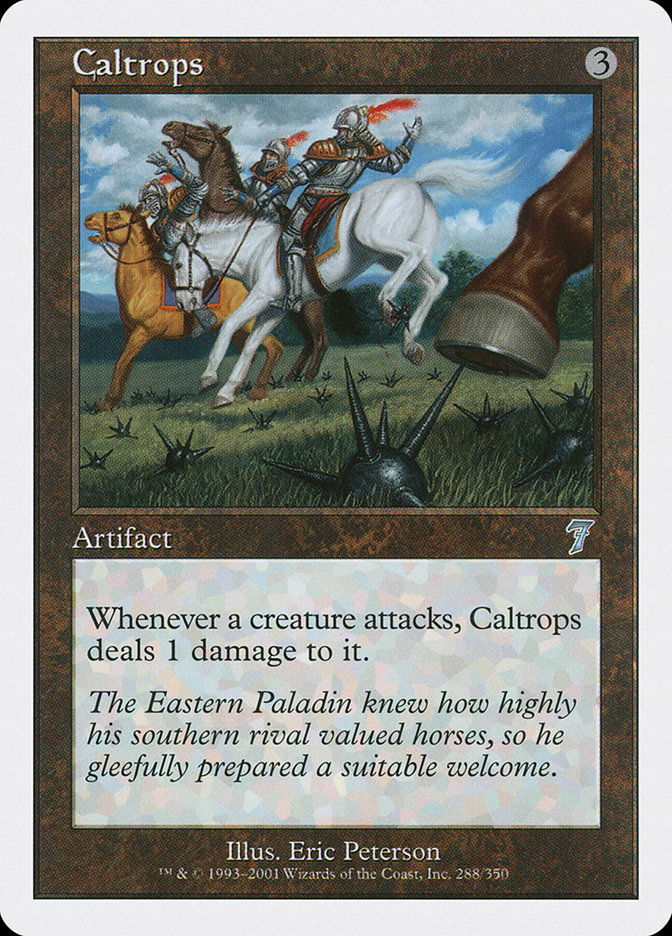
Caltrops does a lot more work than it looks like it would. It's another effective card against small creatures. It also pressures large creatures once you have a few cards to double your damage in play. Caltrops is another effect your indestructible commander doesn’t care about.
Damage Multiplication
This deck has a couple of ways to double or even triple your damage to help win the game. It’s hard to burn out three players from 40 life, so these are necessary to get the job done.
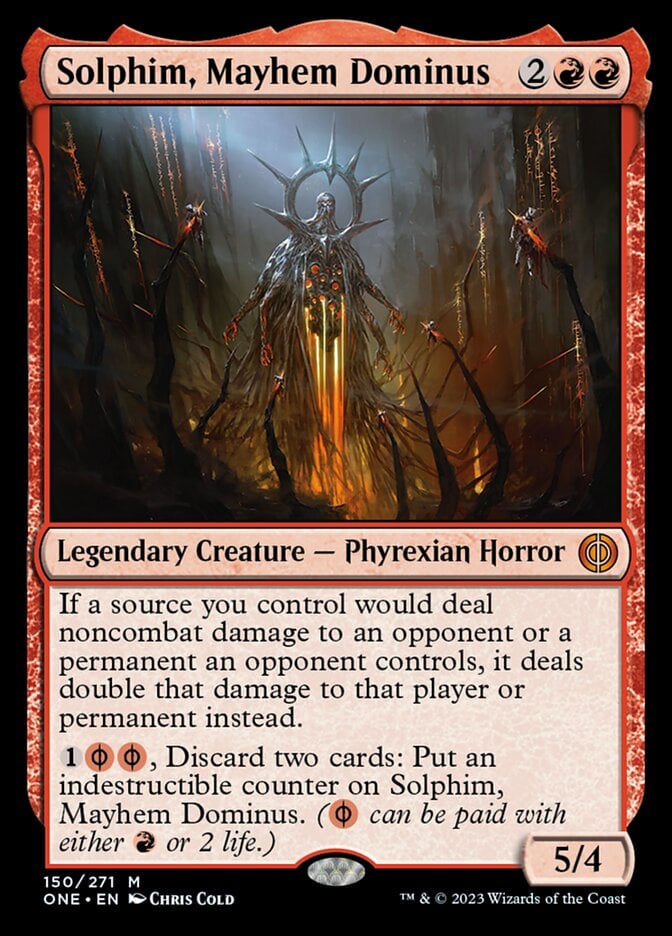
Solphim, Mayhem Dominus is one of the few creatures in the deck, and it doubles all your noncombat damage, which is most of your damage. You can give this indestructible easily, which helps it avoid most of your destruction effects to keep the damage going and give you another threat.

Furnace of Rath is a cheap effect to double damage with a cost: it applies to everybody’s damage, not just yours. Hold this until you have a protective piece up so everybody doesn’t make you archenemy and rush you down with your cards.
Fiery Emancipation and City on Fire are your biggest damage multipliers, tripling all your damage. They're especially powerful with Mogis because this lets it one-shot players; Mogis still deals the damage, so each attack is 21 commander damage.
Group Slug Cards
These are the heart of the deck: the effects that deal damage whenever an opponent takes a game action.
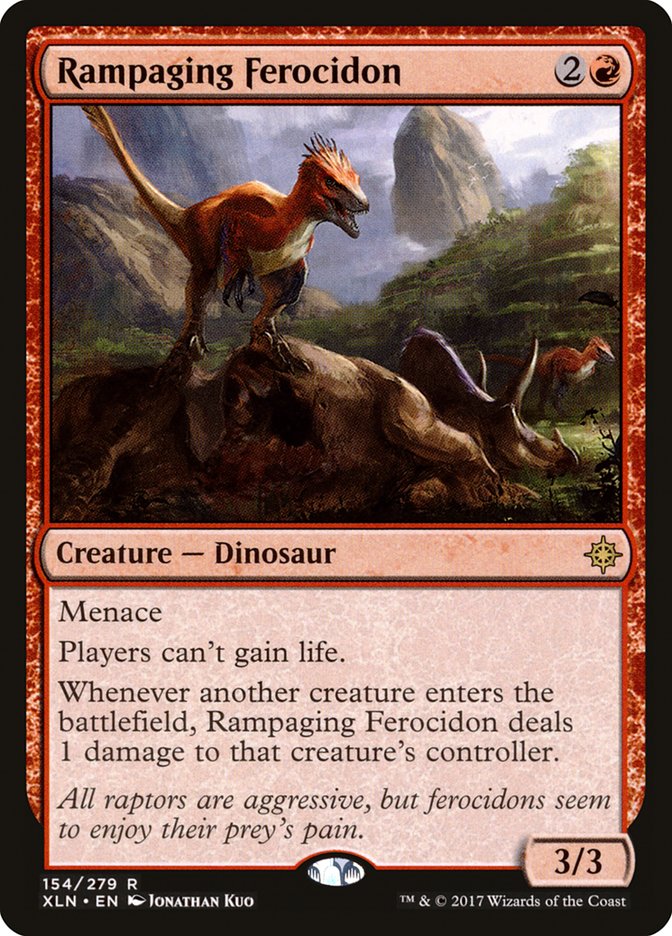
Rampaging Ferocidon punishes creature decks and prevents your opponents from gaining life so they can’t outlast you. It’s effective against combo decks that do tricks like flickering Dockside Extortionist or creating infinite creatures.
Underworld Dreams and Kederekt Parasite strike at your opponents drawing cards to find answers. These are some of your best steady sources of damage. You’ll have red permanents pretty often since it’s hard to remove Mogis, so it takes next to no work for the Parasite to do a bunch of damage from turn two or three.
Ankh of Mishra and Polluted Bonds punish your opponents for playing lands before they get destroyed in a real damned if you do, damned if you don’t scenario. The life gain from the Bonds is quite helpful since many of your effects are symmetrical.

Manabarbs also punishes your opponents for trying to play the game, every time they try playing a spell. It’s a bit of a negative combo (nonbo) with your land destruction effects, but this does tons of damage to floundering opponents.

Rug of Smothering punishes players trying to play multiple spells. It racks up damage incredibly quickly; two spells make your opponent lose three life, three spells make them lose six, and so on. This is loss of life, not damage, so your damage multipliers won’t affect this.

Spellshock shocks your opponents for every spell they cast, forcing them to choose which spells they play carefully. This and Manabarbs often lead to many spells costing five or more life to play, which takes players out very quickly.
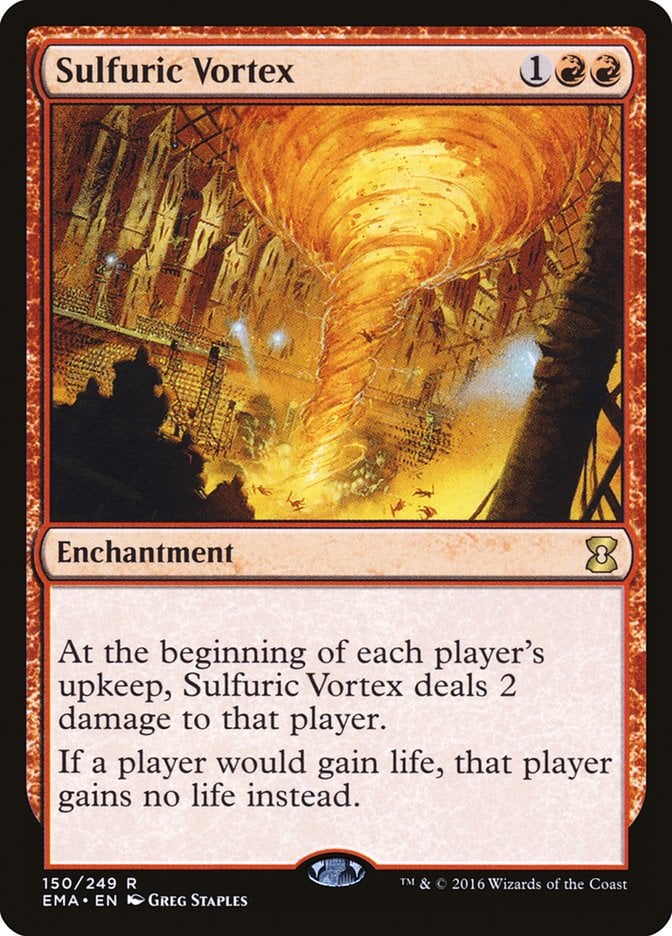
Sulfuric Vortex is a classic burn piece that helps shut down life gain while dealing consistent damage to everybody. It stacks well with Mogis and your other effects to put a quick clock on opponents and gives you more anti-life gain pieces, which are very important.
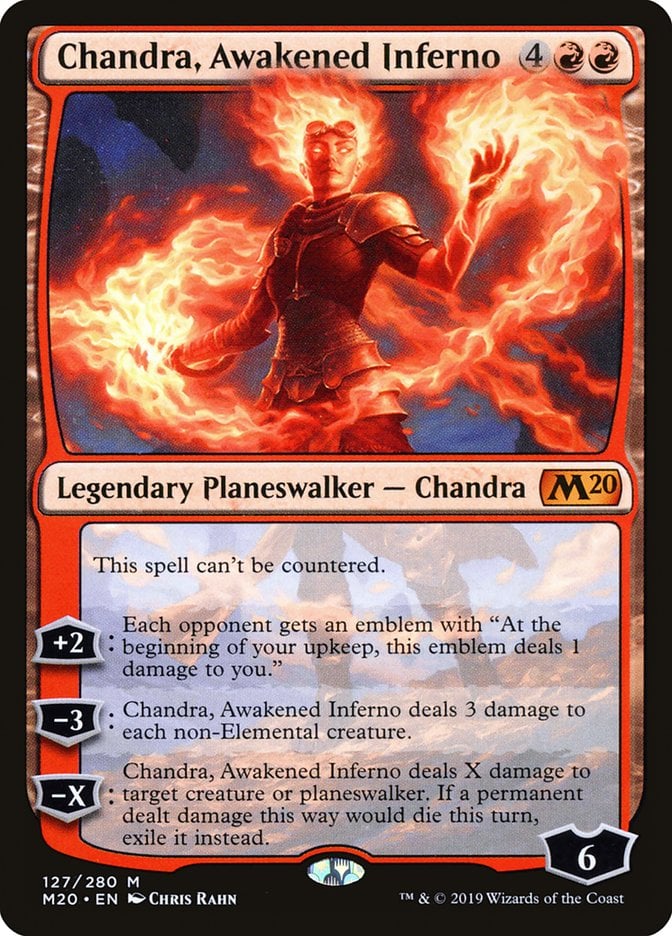
Chandra, Awakened Inferno is one of your strongest win conditions. Most of your board resets ignore planeswalkers. Even if Chandra is destroyed, your opponents can’t do anything about the emblem it leaves behind. You want to uptick your planeswalker as soon as you play it to get that steady damage. Note that your opponents control the emblem, so the damage multipliers that increase the damage from your sources won’t affect that damage.
Interaction
You have ways to impede and slow your opponents, but you’ve also got a handful of other interactive pieces to help stem the bleeding.

Dreadbore gives you some important planeswalker interaction since those often escape your destructive abilities.
Damnation, Toxic Deluge, Brotherhood's End, and Blasphemous Act give you a variety of wraths to use at multiple points in the game to keep the board clear. Brotherhood's End can also destroy cheap artifacts to stop your opponents from ramping around the land destruction, but that’s a tricky mode to deploy since it can do the same to you.
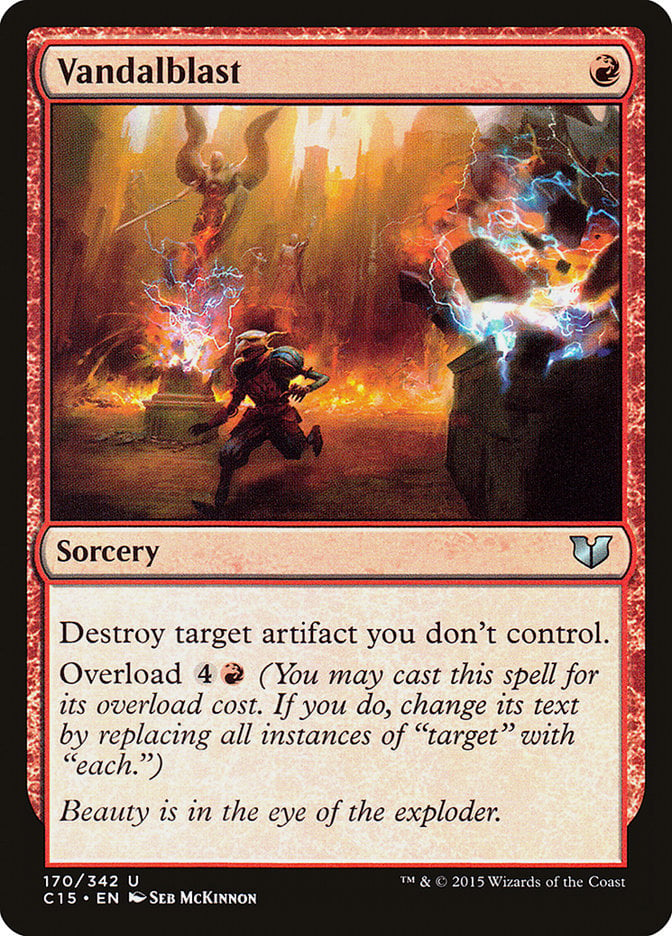
Vandalblast gives you no such limitation. You’ll always want to overload this right before casting a wrath so you can take out any mana rocks that might help opponents play the game after losing all their lands.
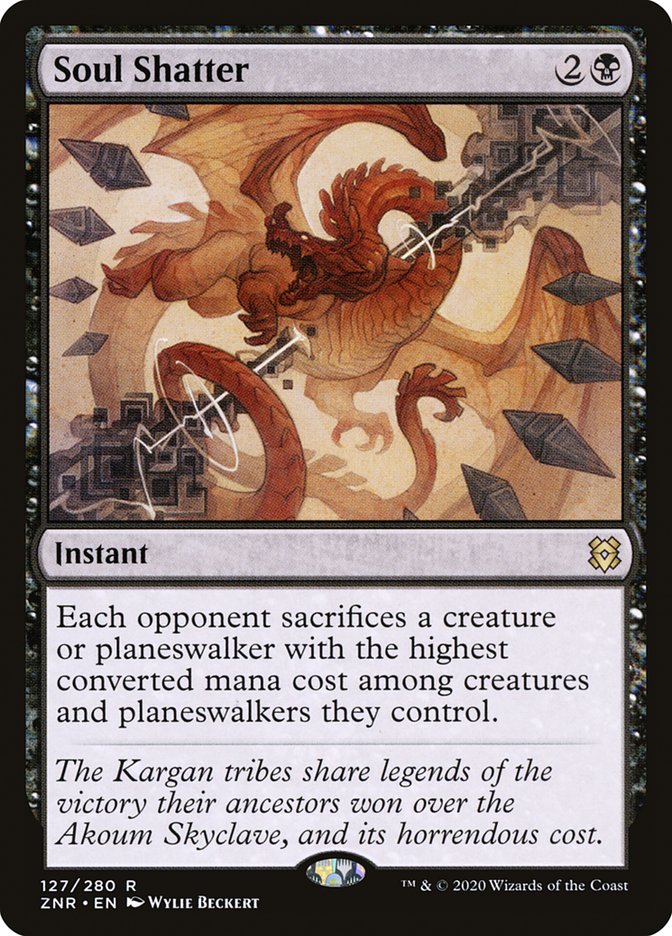
Soul Shatter is a card I consider criminally underplayed in Commander. It’s always a three-for-one and circumvents many of the traditional weaknesses of an edict by forcing opponents to sacrifice something relevant. It might not be the exact creature or planeswalker you want to remove, but it prevents opponents from sacrificing random tokens or mana dorks.
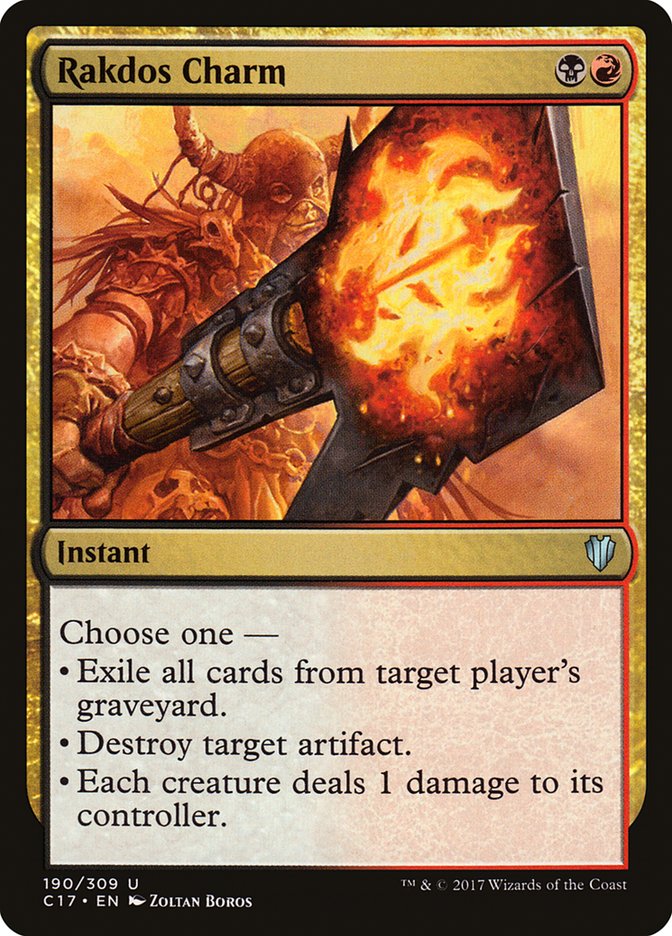
Rakdos Charm is a nice little card that can finish the game or disrupt an opponent trying to do something with their graveyard or artifacts. It’s not flashy, but it gets the job done.
The Mana Base
Your mana base has a bunch of mana rocks to help accelerate your big spells and reduce the impact of your land destruction on your ability to cast spells. You’re playing the playable 2-mana rocks in your colors, but I want to highlight a few particular pieces of this mana base.

Planar Atlas is a lovely little mana rock from Jumpstart that does a pretty good imitation of Cultivate. The strength of Cultivate is that it ramps you while ensuring you get another land drop following that. The Atlas has a similar effect, smoothing out your draws by finding lands when you need them, and you can decline when you don’t.
Crucible of Worlds isn’t a ramp piece, but it’s an important part of the mana base because it helps break the symmetry of your land destruction spells. Wildfire is much less devastating when you can replay the lands from your graveyard.
Realmbreaker, the Invasion Tree is an interesting inclusion from MOM. Ramping with lands is a bit risky in a land destruction deck, but the first Ruination is enough to buy tons of time. This disrupts opponents trying to get lands from their graveyard with their own Crucible or Ramunap Excavator.
The land base has a couple of choice lands to help with your strategies. It runs minimal nonbasics with a full twenty Mountains and Swamps to help make cards like Blood Moon and Ruination as one-sided as possible.
Drossforge Bridge and Darksteel Citadel are indestructible lands to leave you up a few mana after you blow up the world. Try to avoid sacrificing these to effects like Wildfire or Tectonic Break where you can.
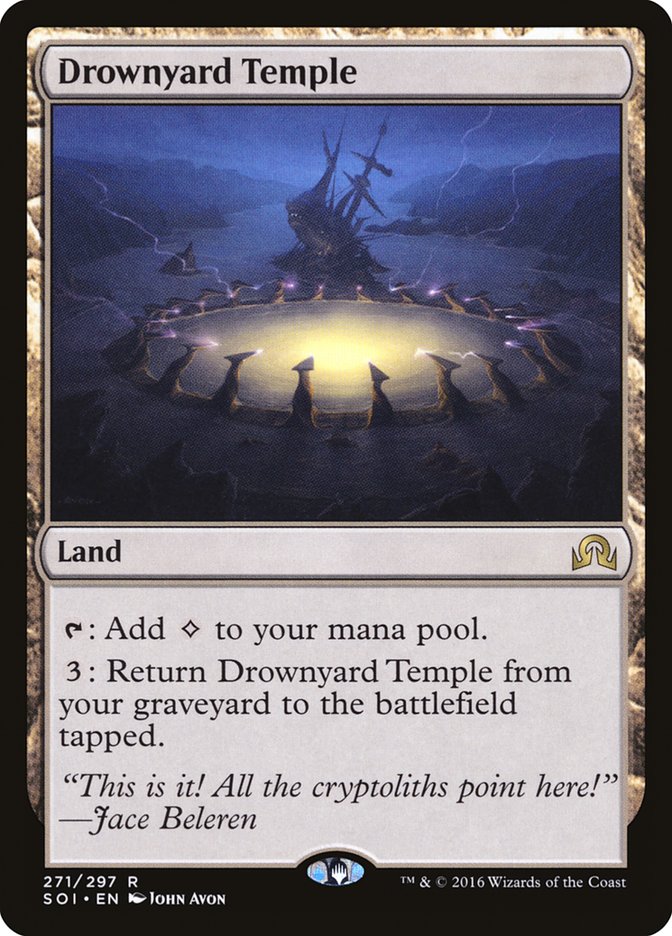
Drownyard Temple is a land you’re happy to sacrifice. Bringing it back gives you something to do with your mana in turns following some land destruction and gives your mana base some resiliency against its strategy.
The Strategy
This isn’t a deck for the faint of heart. As you’ve noticed, many of your damage-dealing effects are symmetrical. You’ll take damage alongside your opponents as you blow up their lands, becoming public enemy number one. To pilot this deck effectively, you need to go full throttle from the start.
Part of what makes Mogis, God of Slaughter so effective is that it helps “break” the symmetry by dealing damage just to your opponents. This leads to your opponents taking four damage every upkeep you have a Sulfuric Vortex and Mogis in play, while you’re only taking two, and so on.
This is also why you need so many defensive pieces. You can’t afford to get attacked; it’s better to have your opponents attacking each other. You can also attack with Mogis to force everybody else to die faster than you.
The biggest things to look for in opening hands are ramp and protective pieces. The rest fall into place; if you can get ahead on the mana curve and deploy an Ensnaring Bridge or Crawlspace, you’ll have enough time to find some land destruction or punishing effects that deal with your opponents.
You want to try and maneuver yourself to an empty board state. One of the easiest ways to win with this deck is ramping out Mogis then dropping a Jokulhaups and making your opponents take damage while they try to rebuild their board state.
Before casting one of your hard resets, you want to ensure you have some strategy. That usually looks like having a couple of enchantments or planeswalkers in play; you’re not running Worldfire specifically because it doesn’t enable those strategies. It’s not a fast clock, but it’s effective. Again, restarting the game with a Mogis or Underworld Dreams in play is a game plan.
The biggest threats to this deck are lifegain strategies and go-wide creature decks, so you have many pieces to combat those strategies. A dedicated lifegain deck can outlast you, gaining life faster than you can deal damage, making you lose to your burn cards. Since you have so few creatures, it’s hard to deal with massive swarms of tokens.
Strategies built around producing a single large monster aren’t nearly as problematic; they get shut down by a removal spell. Those strategies naturally struggle against your land destruction, since they’d need to ramp, and you just stop that.
Use your opponents’ commanders to help determine how you mulligan. If there’s an Oloro player, see if you can’t find a way to stop life gain. Look for wraths against tokens commanders, and so on.
Combos and Interactions
This deck doesn’t have any infinite combos or complex interactions. You play burn spells and damage multipliers, blow up some lands, and call it a day.
There’s one combo: Caltrops with Death Pits of Rath.
Caltrops works well with any damage multipliers, but it’s at its best when you have Death Pits. Any creature that attacks take damage, causing the Death Pits to destroy it. This two-card combo is the best protective piece in the deck. The only creatures that get around it are those with indestructible (like your commander!) or ones with protection from artifacts.
Rule 0 Violations Check
This is the biggest red flag in a rule 0 discussion, full-stop. This isn’t a deck to take to a new playgroup without explaining what it does. The entire point of the deck is to slow the game to a crawl by destroying everybody’s lands and dealing chip damage over time.
It’s hard to conceive of a deck that violates rule 0 harder without actively bringing a cEDH deck to a casual pod. That said, this is a fantastic deck for the right playgroup. It has lots of interesting choices and is challenging to pilot since you need the right balance of defensive pieces with protective plays while avoiding the dreaded archenemy title. Just don’t unleash this on unsuspecting players.
Budget Options
Daretti, Ingenious Iconoclast is an incredibly powerful planeswalker. It gives you some sorely needed blockers and lots of interaction but costs a ton. A good alternative could be Ob Nixilis, the Adversary to pressure your opponents’ hands instead of the board.
Erebos, God of the Dead gives you another way to stifle life gain, and it’s an indestructible creature to attack with. Tainted Remedy can fulfill the more important role of stopping life gain.
Toxic Deluge is one of the best wraths ever printed but could be swapped with Storm's Wrath or Anger of the Gods for a less effective, but cheaper option. You could switch Damnation with one of these substitutes.
Crucible of Worlds gives you some resiliency to your strategy but could be replaced with another mana rock like Worn Powerstone to preserve your mana and your wallet.
Polluted Bonds gives you some much-needed life gain and an asymmetrical damage effect but has a high price since it was only printed in Lorwyn. Zo-Zu, the Punisher will do in a pinch.
Fiery Emancipation is an important damage multiplier for the deck, but you can substitute Dictate of the Twin Gods for a cheaper enchantment to up your damage.
Other Builds
What else can you do with Mogis, God of Slaughter if you don’t want to blow up the world? You could build it as a more traditional aggressive deck, using lots of cheap creatures like Professional Face-Breaker and Rotting Regisaur to put a lot of pressure on your opponents while amassing enough devotion to turn Mogis into your most reliable attacker.
You could also use it in an Aristocrats-style deck with lots of edict creatures like Fleshbag Marauder and Plaguecrafter to keep constant pressure on your opponents’ boards, preventing them from developing any creatures and making them take a ton of damage.
Commanding Conclusion
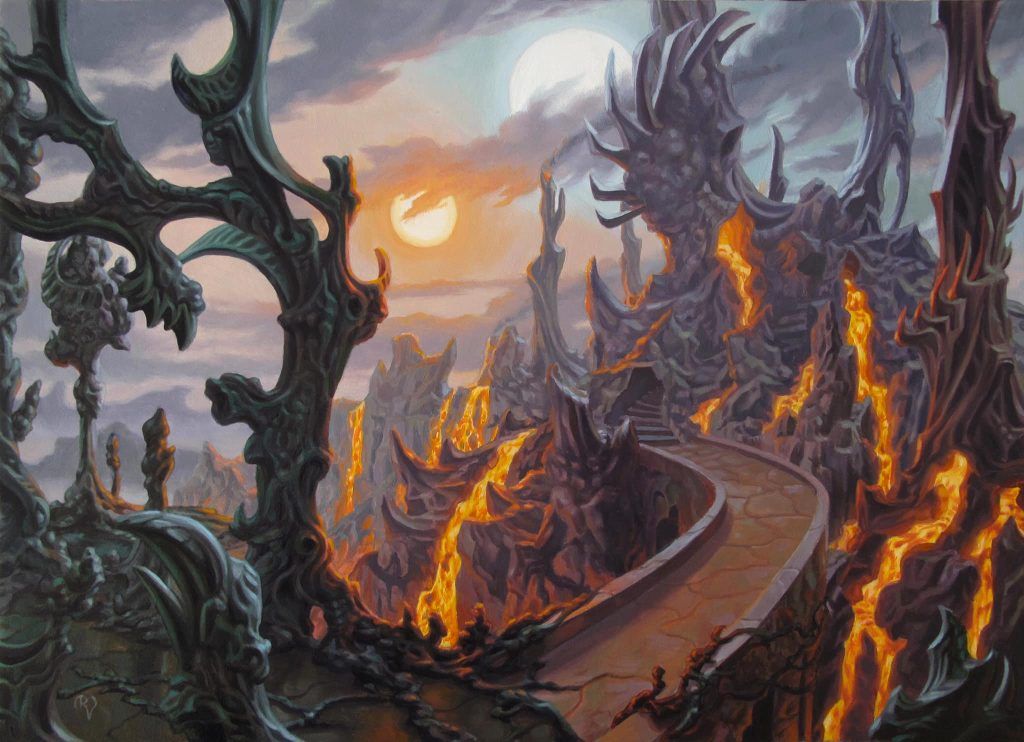
Drossforge Bridge | Illustration by Raoul Vitale
Sometimes, you play Commander to foster a fun and exciting environment where everyone shows off their thing and make flashy plays. Sometimes, you want to see how quickly you can end a game and watch the world burn.
This is a great list for the latter. The deck requires you to go all-out and put your ability to win on the line, as you’ll potentially be taking damage as quickly as your opponents. It’s not the deck for every playgroup but is tons of fun at the right table.
Do you prefer group hug or group slug? Which Theros god is your favorite to build around? Let me know in the comments or on the Draftsim Discord!
Stay healthy, and slug your table!
Follow Draftsim for awesome articles and set updates: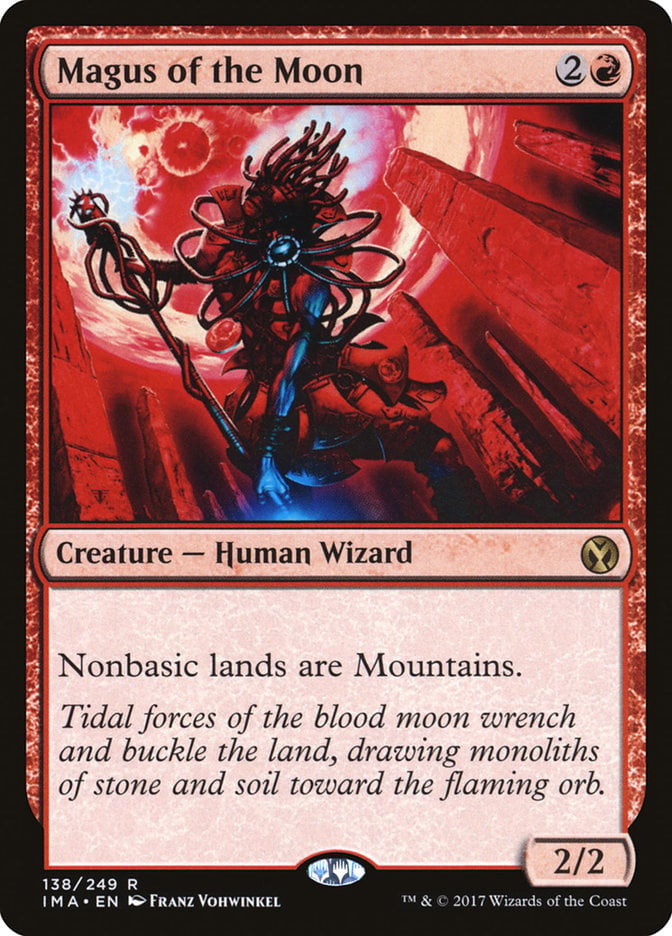
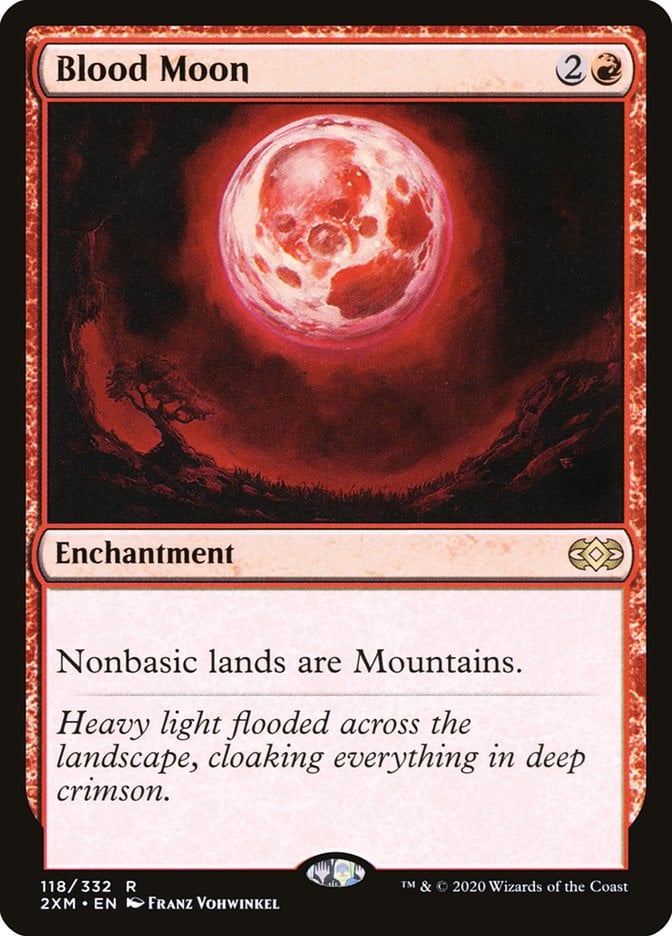
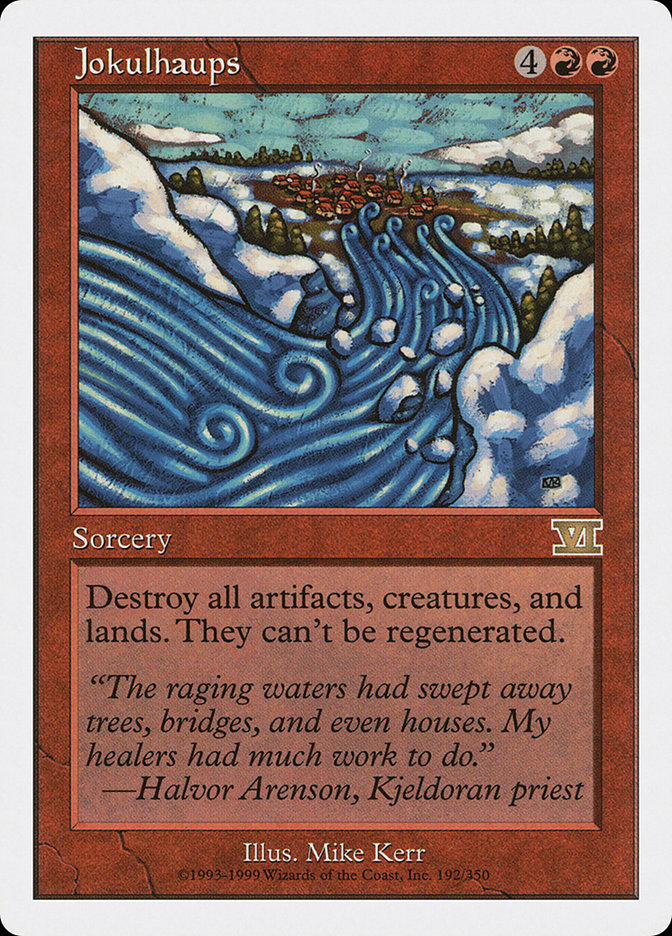

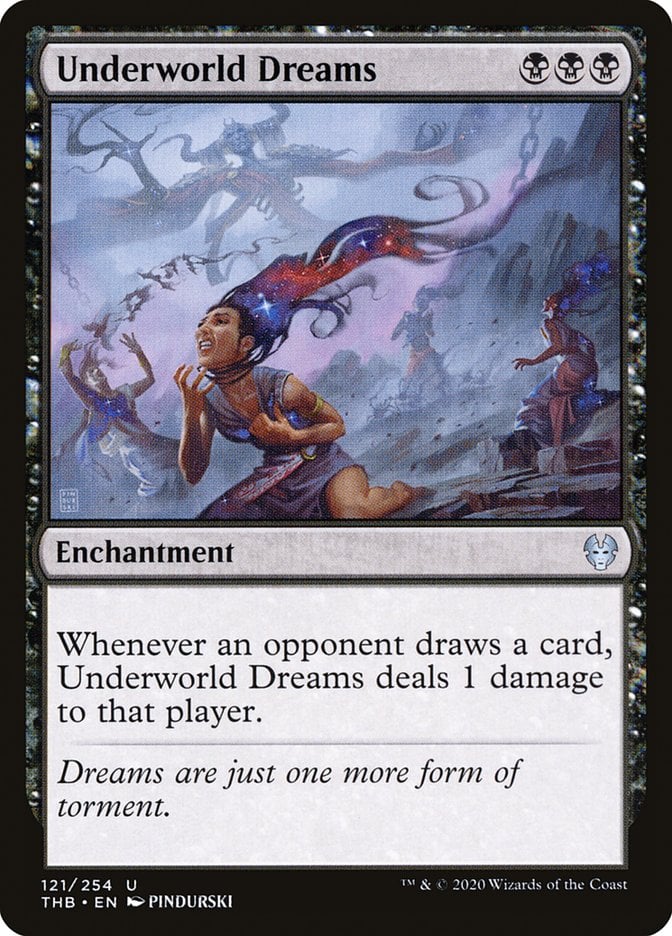
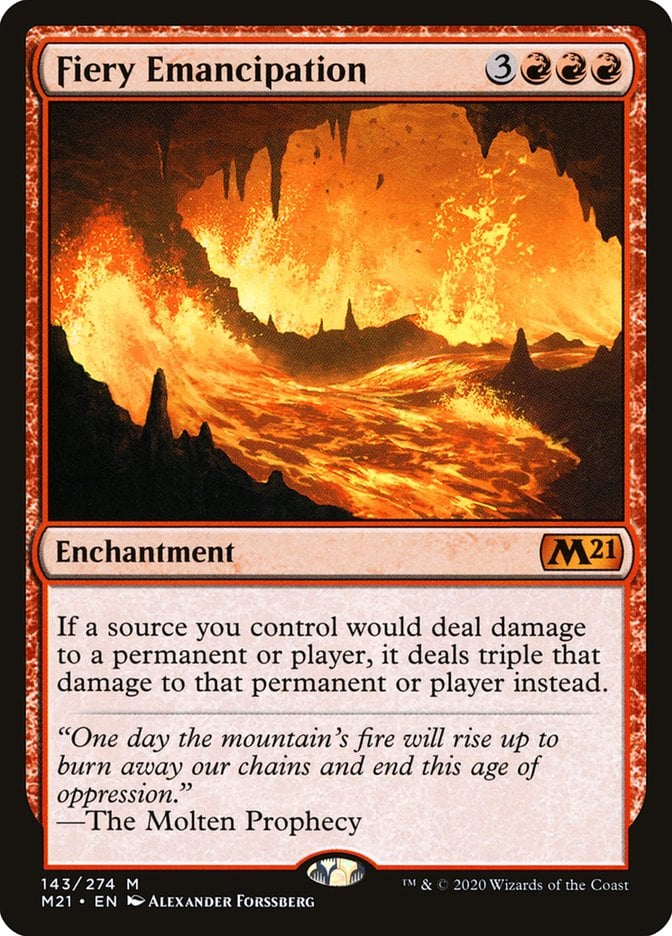

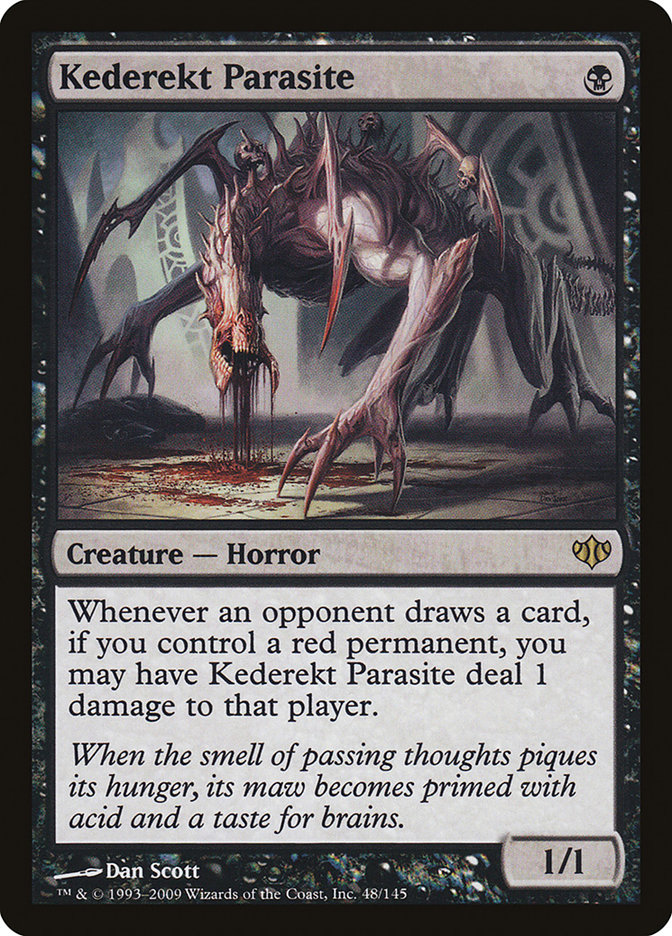
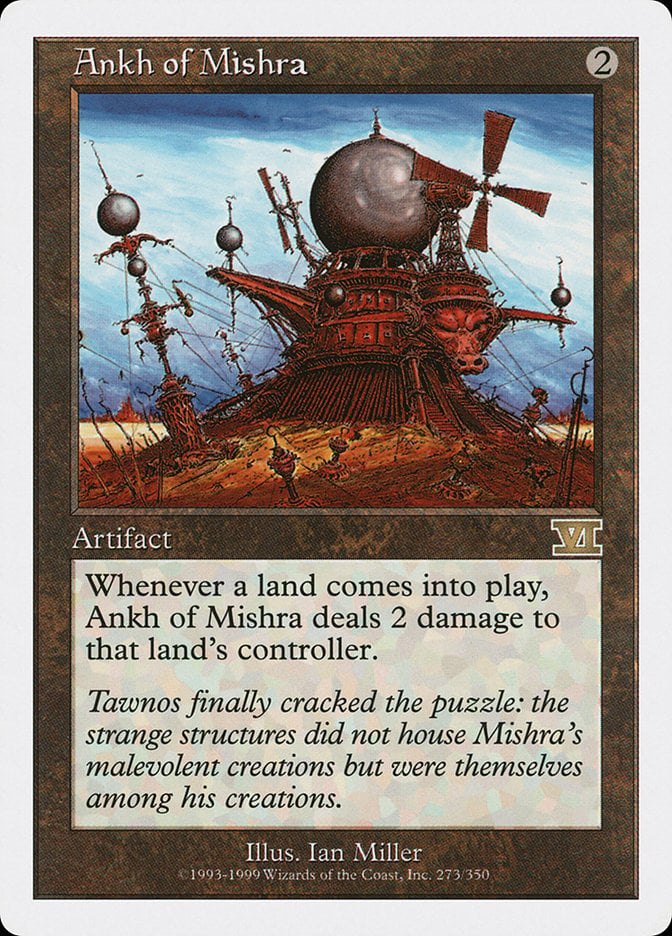



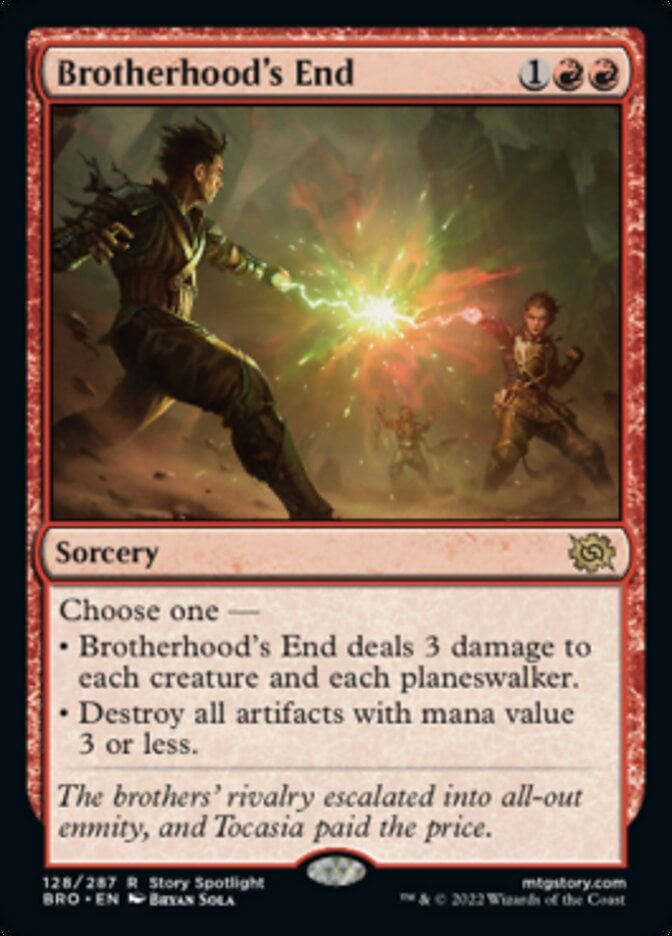
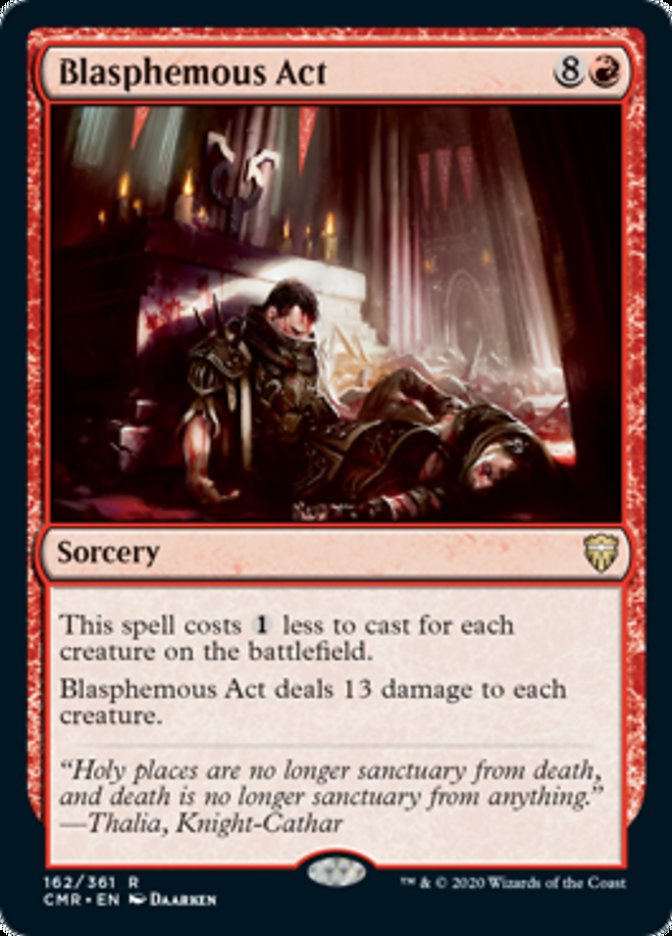

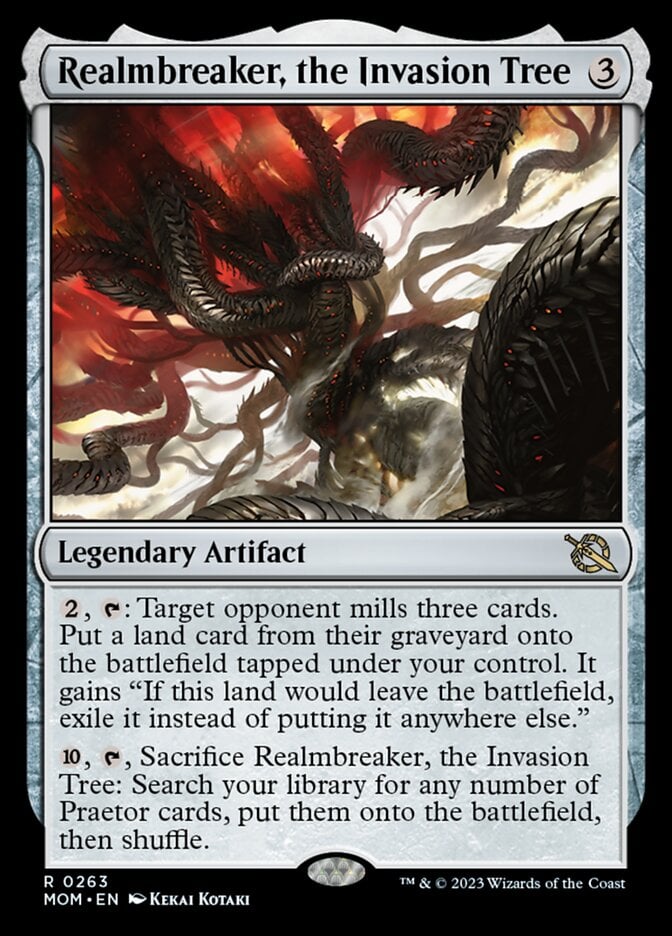

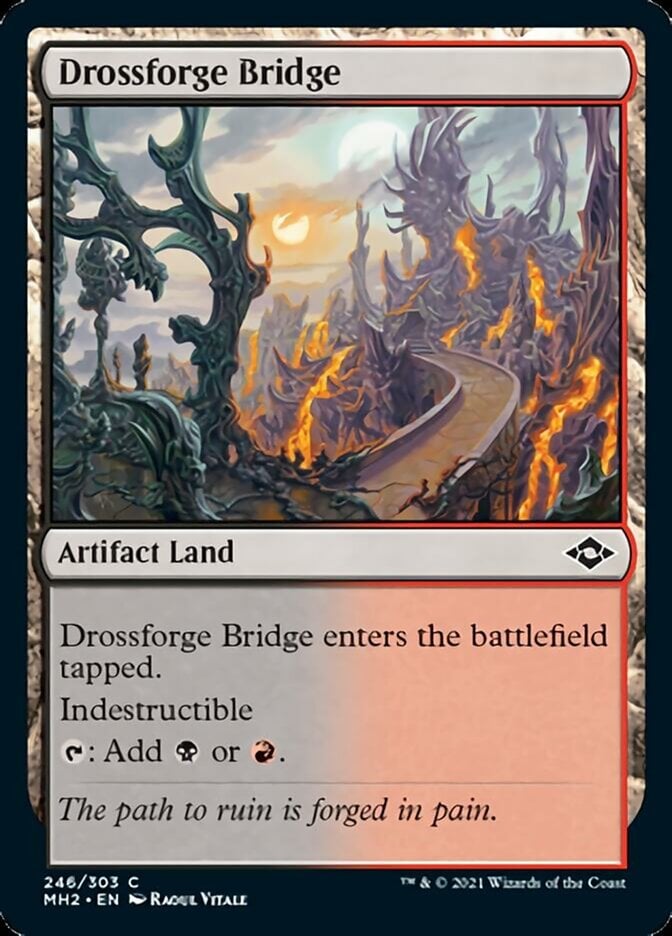

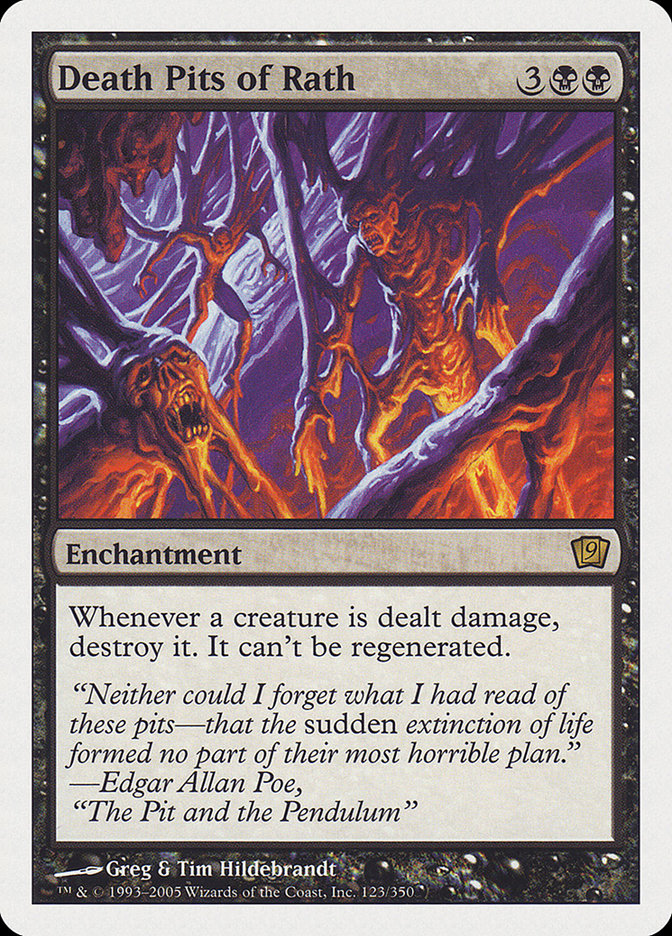
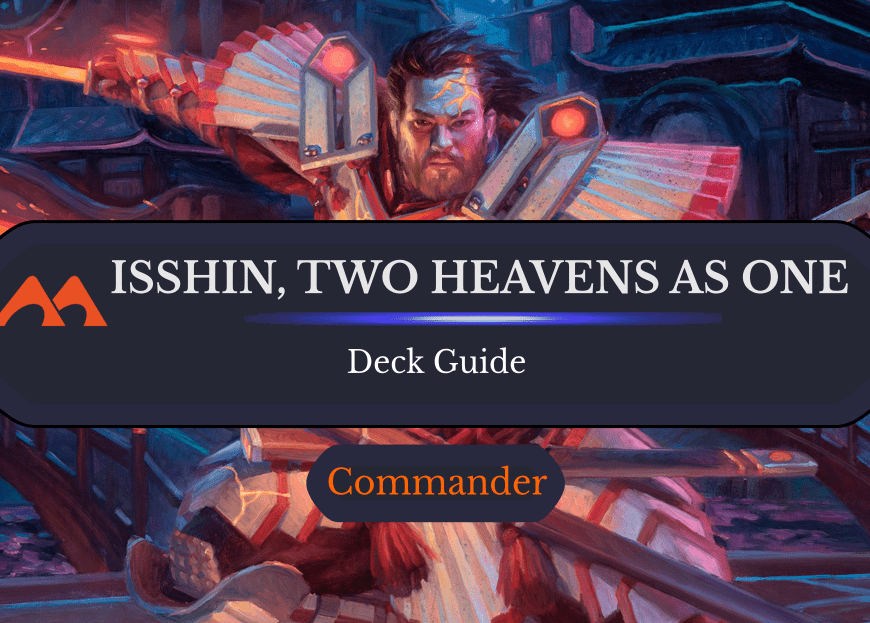
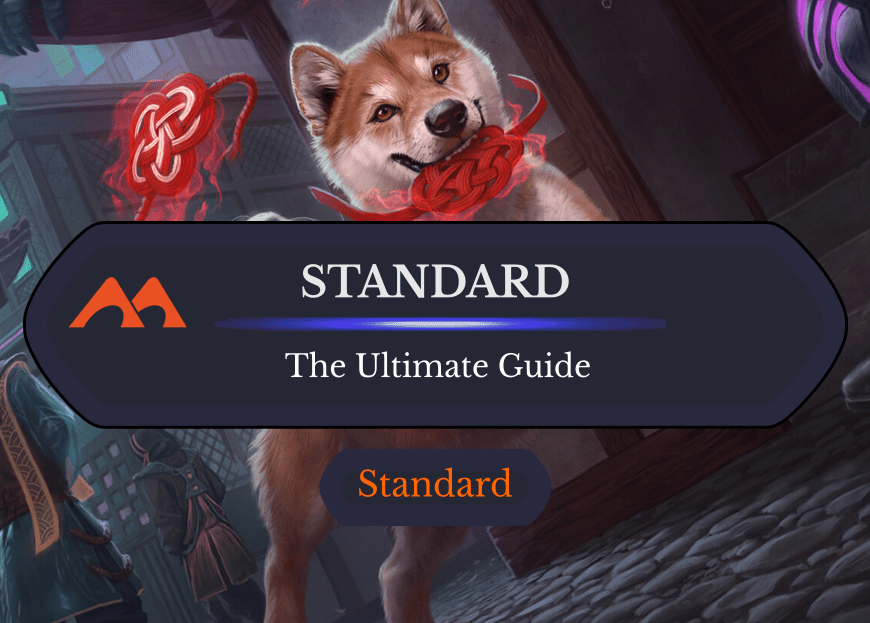
Add Comment